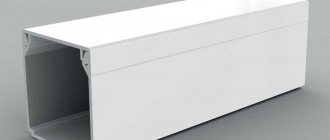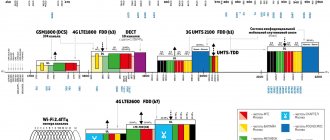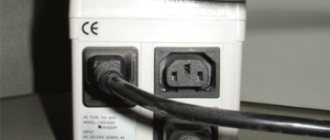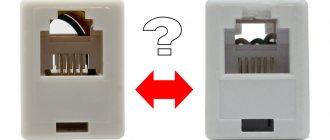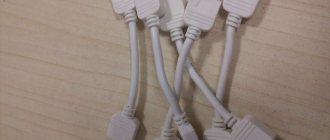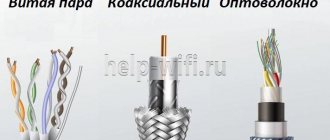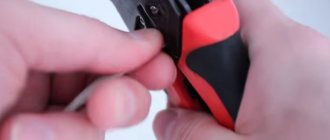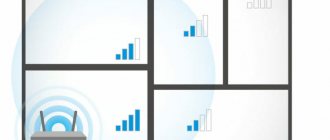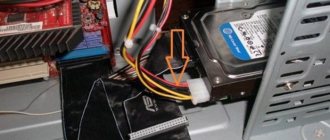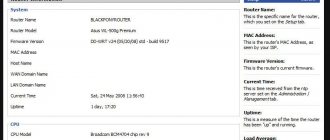And although 2-pair cables are lighter, cheaper and more flexible than their counterparts, we recommend using only 4-pair cables. Firstly, they have high throughput. A 2-pair cable will provide you with a maximum speed of 100 Mbit/s. Secondly, even if your network equipment is not capable of transmitting speeds greater than 100 Mbps, you will receive a backup unused pair of wires in a 4-pair cable. It will come in handy if the main pair is damaged. Thirdly, this is a good foundation for the future. You don't have to re-run the cable when you want to get Internet at a speed of 1-10 Gbps.
Main types
Currently, various types of cables are used to increase the speed of information transfer in networks. Their main difference is their technical characteristics.
Three main types are used:
- Twisted pair;
- Fiber optic;
- Coaxial;
Important. In addition to the cord itself, it is equally important what type of core and how the product is shielded.
twisted pair
Twisted pair cable is the most common method of data transmission in local networks. Each cord includes a set of stranded, insulated copper wires in pairs. A regular cord contains 4 pairs of conductors. The industry also produces wire with only 4 cores.
The insulation is painted in standard colors. The main requirement for laying networks is the need to locate all devices at a distance of less than 100 meters.
Depending on the insulating braid, twisted pair cables can be divided into several categories:
- UTP – without protection. Apart from their own plastic protection of the cores, no insulation is provided.
- F/UTP - a layer of reflective foil is fixed on top of all conductors.
- STP (secured). Each of the conductors is covered with an additional layer of shielded film. Additionally, a mesh screen is used.
- S/FTP – foil, shielded pair. Each pair of conductors is in its own braid, and for reliability, the wire itself is protected by a copper shield.
- SF/UTP – a double screen is attached for protection: copper film and foil.
Fiber optic network cable
Important. This Internet cable is the fastest way to transmit information. It is used to transmit data via the Internet to another part of the world and to other countries.
Main advantages of the cable:
- High throughput.
- Long service life.
- It is easy to detect outside interference, which significantly improves data security.
- Noise reduction and protection from various interruptions and interference.
- High data transfer speed.
Coaxial wire
This type of Internet cable for computers is the oldest. It is rarely used to transmit data for television and radio. This type of equipment is practically not used for lan networks and internet.
What types of veins are there?
What are the differences between 3G and 4G networks: features, advantages and disadvantages
There are two main types of cores: copper-plated and all-copper.
Copper-plated
This type of wire consists of a composite material that has reduced conductivity. The core is made of metal with reduced conductivity, and the outer covering is made of copper.
Number of cores
Twisted pair for the Internet can include 4 or 8 wires, depending on the purpose. The wire is selected based on the requirements for the network and its functional purpose.
Comparison of optical fiber and twisted pair
To determine which wire for the Internet is better to purchase - optical fiber or twisted pair, you need to decide under what conditions it will be used.
For a regular connection of a computer to a network, twisted pair cables work well. It is inexpensive, easy to install, and the transmission speed is sufficient for home and office use. This computer cable for the Internet bends well and can be stretched in the most inconvenient places. If by chance it gets damaged, it is easy to replace it, because the price is very low.
Fiber optics for home and office are expensive due to the equipment; using it as a wire for a local network is unjustified. The main advantage - the significant speed of information transfer - does not justify the costs, since several computers are not capable of creating the kind of traffic for which it is designed. Optical fiber is used to carry the Internet to populated areas or multi-story buildings. It is not afraid of line interference and long distances, so it is well suited for such tasks.
Thus, a fiber optic cable is usually suitable for a multi-story or private house. And inside the building there is already wiring going on using twisted pair cables.
Network cable device
Different types of Internet cables have different structures. The simplest design is coaxial. The most advanced design of fiber optic wire.
Structure of a coaxial cable
Even at the dawn of the creation of networks, only coaxial cable was used. Its structure includes a central conductor.
Around it is a thick layer of insulation, followed by braiding - aluminum or copper, and finally - an insulating shell.
The top (last) shell is mainly made of polyvinyl chloride and is UV resistant. There are options with Teflon protection, but they are more expensive
Twisted pair device
The optimal cable for the Internet is a twisted pair or Ethernet cable (as it is often called because of the plug of the same name at the end and the connector in the technology where the wire is connected). It is this that allows you to set up a local network between several devices, connect a printer to a computer, and connect the Internet from the supplier to the modem or router.
Such a wire is formed from two or four pairs of copper conductors (four-core and eight-core).
Inside each conductor there is one copper core with a diameter of 0.4-0.6 mm or many small wires. The first one is easier to crimp and is used to connect Internet sockets. The second is more flexible and is designed to connect PCs and other equipment.
Features of the optical cable structure
While users are often familiar with the structure of a twisted pair or coaxial wire, few know what a fiber optic network cable looks like from the inside.
The optical fiber inside consists of many tiny wires separated by a special coating. Each such wire has a silicon core through which these optical rays pass and carry. In addition to the core, it has an optical cladding, a buffer coating and protection.
The shell surrounding the core is made of glass. Light, reflected from it, is distributed throughout the core, but does not leave the wire.
Ethernet to the rescue!
Naturally, if you have a wired network and very fast broadband Internet, you don't want to use a 100 Mbps (Fast Ethernet) connection between your computer and your ISP modem. That would be stupid! You need gigabit internet.
All you need is to connect all your home devices using inexpensive Cat 6 Ethernet cables, and use cheap Gigabit switches as the “nodes” to connect your devices.
My home network looks like this:
Pretty simple, isn't it?
The orange line is a Cat 6 Ethernet cable. You simply connect computers, routers, laptops using these cables and everything “just works”.
However, you should note that some laptops come with cheap built-in Fast Ethernet adapters that offer connection speeds of no more than 100 Mbps. If you have this situation with your computer, buy a gigabit USB-ethernet adapter.
Marking
All that remains is to determine the length and get acquainted with the cable markings in practice.
The main indicators are:
- U/UTP – unshielded;
- Cat5e – category 5e for 1 Gbit/s local area;
- PVC – polyvinyl chloride, shell;
- 4x2x0.48 – four pairs of two wires with a cable cross-section of 0.48 mm;
- Solid - a rigid type of core core (does not bend much, but has lower losses during signal transmission).
Choose the length based on the tasks for now, and not in reserve. Otherwise, this loop of wire will remain a loop for many years.
registry С
Cat5 - OPEN RESULTS й. 100 rubles. 2 points 100 Mbit/s, remote connection 1 Gbit/s.
Cat5e - FTP, FTP ¹ 4 collateral. 125 125 2 points 100 Mbit/s, 100 Mbit/s 1 Gbit connection /s в ÑекÑндÑ.
Cat6 â ÑабоÑÐ°Ñ ÑаÑÑоÑа 250 мегагеÑÑÑ, Ð¸Ð¼ÐµÐµÑ 4 паÑÑÑж иÐ" и пÑи иÑпоÐ"Ñз 1 Gbit/s 1 Gbit/s RUR 50 RUR RUR 50 RUR RUR Ð ´Ð¾ 10 Gbit/s.
Conductor materials
Conductors in pairs are made of copper, aluminum and bimetal (copper-bonded aluminum). Initially, the conductor material was exclusively copper. However, copper has a drawback - it is high cost, and therefore aluminum, and later bimetallic twisted pair, which costs less than copper, appeared on the market. But are such savings beneficial in the long term? To obtain a high-quality and long-term operating network, and even more so to pass certification, it is only possible by using copper conductors.
- Aluminum conductor (Al) - Aluminum is much lighter than copper - about three times. Well, its main advantage is that it is much cheaper than copper. That's where all the positives ended. The electrical conductivity of aluminum is 1.7 times lower than that of copper, that is, it has higher resistance, which means signal loss with a long cable length. Aluminum is an amorphous material, so over time it “leaks” from the contact, and the signal disappears completely. Also, this metal is susceptible to oxidation when in contact with air, and the surface of the twisted pair loses conductivity over time. Aluminum is less elastic than copper, and twisted pair conductors are twisted together, and the cable itself usually does not lie in a straight line.
- Copper-Clad Aluminum (CCA) - In an attempt to eliminate the shortcomings of aluminum conductor, namely oxidation, copper-clad aluminum conductor was created. Essentially, we have the same aluminum conductor enclosed in a copper sheath. It still beats copper conductor in cost, but due to the complexity of manufacturing, the difference in price is no longer so significant and amounts to about 15%. The conductivity has also become much higher, but it is still lower than that of copper. The copper surface prevents the formation of a surface oxide film and thus allows the quality of the connection to be maintained. And another plus is the weight, since most of the conductor is made of aluminum, the cable is much lighter than copper. Of the minuses, it can be noted that it still cannot be used with Power over Ethernet (PoE) technology, which provides power to devices using the same cables, since the resistance of aluminum is much higher than the resistance of copper, and direct current will flow across the entire cross-section of the conductor, the main part of which is aluminum. And from experience and practice, it is very difficult to find a truly high-quality cable; most of what is offered on the market, when tested, gives a fairly wide range of parameters, and, as a rule, does not correspond to the declared category. In most cases, when using such a cable, it was not possible to configure the network’s functionality even over a short distance (60-70m).
- Copper (Cu) - The use of copper conductors allows you to avoid a large number of problems and significantly increase the service life of such networks, as well as reduce maintenance costs. But you should come to terms with the fact that the cost of a network built using copper twisted pair will be higher than the cost of the same networks laid with copper-plated twisted pair.
There are two types of conductors - solid (from one wire) Solid and twisted (from many thin wires closely adjacent to each other) Stranded. Solid means that the inner conductor is a single piece of copper, while stranded means that the inner conductor is made of several thin copper conductors twisted together. Each type of conductor has different applications, but most readers only need to know about two of them.
Stranded cables (Stranded, pictured above) are more flexible and should be used where the cable will move frequently, such as near work areas. A solid cable (Solid, in the picture below) is not as flexible, but it is more durable, it can be ideally used for permanent networks - both outdoors and indoors.
The cross-section of each twisted pair core is marked in accordance with the AWG (American Wire Gauge) standard. The most common conductors are 26 AWG (0.13 mm²), 24 AWG (0.2 - 0.28 mm²) and 22 AWG (0.33 - 0.44 mm²). The cross-section of a conductor refers to the direct cross-section of the conductive material without the thickness of its insulation.
It is necessary to pay attention to the fact that the smaller the AWG, the thicker the conductors and the better the twisted pair cable in terms of characteristics, since the cross-section is larger and the resistance is lower. That is, a twisted pair cable with 22 AWG conductors will be better than a twisted pair cable with 24 AWG. But such a cable will also be more expensive, since it contains more copper.
Category 5e cables have 24 AWG conductors, while higher quality cat.6a, cat.7, cat.7a cables have 23 AWG, and some manufacturers use 22 AWG twisted pair conductors.
Crimping diagram
Perhaps pseudo-graphics with a crimping scheme look better, but:
1. It cannot be printed on a black and white printer.
2. It cannot be opened on a mobile phone without table support.
3. A text description is better in this case.
91.199.245.226 13:22, August 9, 2008 (UTC) 91.199.245.226 13:22, August 9, 2008 (UTC)
Perhaps the text description is better, but judging by the text, in all options you need to connect the first contact with the first, the second with the second, the third with the third, and so on until the eighth with the eighth. The only difference is the color of the wires. Kill me, somebody. Now I’ll go look online for how to crimp a cable; before I had to look it up on Wikipedia. Thank you for the article.
You can return the diagram and leave a text description, it will be more clear. And it is also written:
Are you saying that when cross-crimping the wires do not change places?!?! And it is advisable to align it along the length of the horizontal line. Kys 05:18, 15 August 2008 (UTC)
At 10BASE-T the circuits are prettier. In the sense of attractiveness and brevity.
Actually, there is absolutely no need for diagrams if you remember the fundamental principles: two pairs at the edges, one pair in the middle, the last pair is divided around the middle one. For a crossover, respectively, the leftmost and middle divided ones change places - and that’s it, the color doesn’t matter at all.
Why was the old picture with the crimping diagram removed? It was much more convenient. And this is some kind of little thing that needs to be looked into. What didn't you like about the old one?
Actually, it can be increased, no question. The question is, is it necessary? PS about printing the cutting diagram on a b/w printer, read BOR, there was about it.—Mixabest 08:52, September 21, 2010 (UTC)
Cable selection criteria
This cable has many characteristics, but only some of them are important for selection. These include: conductor category, core type, shielding method. Let's look at each of them in detail.
Category
There are 7 categories of wire in total.
- Categories 1, 2, 4 are almost never used. Type 3 is selected for telephone lines.
- Categories 5 and 5e have almost no differences; the fifth is actually not on sale. Since 2010, after the advent of 5E, manufacturers, practically without changing the Internet cable, began to apply this particular category to the shell. It is she who is the most popular today.
- In category 5E there is a 2-pair (4-core) or 4-pair (8-core) cable with data transmission up to 100 and 1000 Mbit/s. Also, a four-pair cable is laid for networks with a speed of 1 Gbit/s. The maximum allowable distance for it is 100 meters.
- Category 6 consists of four pairs and is intended for networks with speeds up to 10 Gbit/s. For speeds up to 1 Gbit/s, the maximum wire length is 100 meters, for speeds up to 10 Gbit/s – 55 meters.
- Categories 6a, 7 and 7a are shielded cables for networks with speeds up to 10 Gbit/s and highways up to 100 meters. The use of such a screen means increased requirements for equipment and installation (good grounding is required), so most often the use of fiber optics is preferred over this wire.
| Category | Frequency, MHz | Signal transmission rate, Mbit/s |
| 5 | 1-100 | 10, 100 |
| 5e | 1-100 | 10, 100, 1 Gbit/s (eight-core cable) |
| 6 | 1-250 | 10, 100, 1 Gbit/s |
| 6a | 1-500 | 10, 100, 1 Gbit/s, 10 Gbit/s |
| 7 | 1-600 | 10, 100, 1 Gbit/s, 10 Gbit/s |
| 7a | 1-1000 | 10, 100, 1 Gbit/s, 10 Gbit/s |
It must be remembered that the category only reports on the quality of the Internet cable.
It is mistakenly believed that changing the wire will change the frequency at which it operates. This is not true. The cable operates at the frequency of the network equipment. Replacing a high-quality fifth category with a sixth will not increase the signal speed and communication status.
Cable core type
The core may look like an all-copper conductor or copper-plated. The copper core is considered to be of higher quality in transmitting information over long distances. Copper-clad conductors can be used to transmit data over short distances.
Copper-clad conductors can be partially made of steel and aluminum. Steel ones are considered the cheapest and are subject to mechanical damage. The name of the steel is CCS. Aluminum is commonly called SSA.
Important. If you use a steel or aluminum conductor to lay it over a distance of more than 100 meters, the signal will not be delivered.
Cable screen
Shielding is used to protect core conductors from noise coming from other cables. In addition, the protection compensates for radiation from the pair itself.
If there is a power line with a voltage of up to 380V near the place where the Internet cable is laid from the router to the computer, you will need to purchase a cable with at least one screen.
If the core cross-section of the conductor is 8 squares, with a power of 380 and above you need to choose a wire with two screens.
If high-voltage lines with a power of 1000V or more and thick conductors are laid nearby, and the installation technology involves installing power and network cables in protective corrugations, then you will need to use an SF/UTP cable.
Currently, many types of cables are used to lay networks and connect to the Internet. The most popular is eight-core twisted pair, which includes yellow, brown, blue and green colors and additionally these in combination with white. A more advanced type is fiber optic cable.
Section
Another standard to pay attention to is AWG or wire gauge. The lower this value, the thicker and better quality the cable. UTP 5e twisted pair cables typically use AWG24. In categories 6 and 7 - AWG 23 and 22.
Name options
You've probably heard words like:
- network cable;
- twisted pair;
- twisted pair cable;
- patch cord;
- Ethernet cable;
- Internet cable;
- LAN cable;
- Internet cord.
All these words are synonyms. Used to describe a cord designed to connect network devices to each other. The origin of these synonymous words is to one degree or another connected with the topic of network connection.
The cable from the router to the computer is called twisted pair, due to the peculiarities of the weaving of the cores inside the cable. There are eight of them in total, and they are arranged in pairs (four pairs).
We wrote about which cable to choose for connecting the Internet in an apartment here.
The LAN and Ethernet prefixes are added because of their designation. The first is a local area network, which means connecting computers and other gadgets into one network located at a short distance from each other. The second is the technology for organizing LAN networks.
If the words “network” and “Internet” do not require explanation, then it is advisable to explain the patch cord. A beautiful word borrowed from the English language. Patching cord translated as connecting cord.
Decide for yourself which synonym to use in the lexicon. But remember this:
- Twisted pair is a general name for the wires that are used to deploy a network.
- Patch cord is a generalized name for a ready-made cable that can be used to connect any devices, not necessarily “LAN”. But over the past decades, this word has been assigned to the cable that is used in Ethernet. At the ends of the patch cord there are two identical 8P8C connectors, which many mistakenly call “RJ-45” without adding the letter S.
The RJ-45 standard is used in the 8P4C connector, which is not compatible with the 8P8C. According to one version, the confusion occurred due to the external similarity of the connectors.
How to set up an Internet connection via cable?
To set up direct access to the Internet on a computer, just insert a previously crimped LAN cable from your Internet provider with an RJ-45 plug into the Ethernet port of the PC. Then right-click on the “Start” icon and select “Network Connections” from the context menu.
Sources
- https://kamin159.ru/kak-nazyvaetsia-kabel-kotoryi-idet-ot-routera-k-kompiuteru
- https://Vpautinu.com/internet/kabel-internet
- https://help-wifi.ru/tekh-podderzhka/setevoj-internet-kabel/
- https://sovet-ingenera.com/elektrika/provodka/kabel-dlya-interneta.html
- https://WiFiGid.ru/poleznoe-i-interesnoe/kabel-ot-routera-k-kompyuteru-nazvanie
- https://cable911.ru/faq/14_kakie_est_vidy_i_kategorii_kabelya_vitaya_para/
Previous post What to do if you forgot your Apple ID password
Next entry How to connect bluetooth headphones to a laptop (connecting a bluetooth headset) - windows 7, windows 10, windows 8, wireless, I can’t connect
